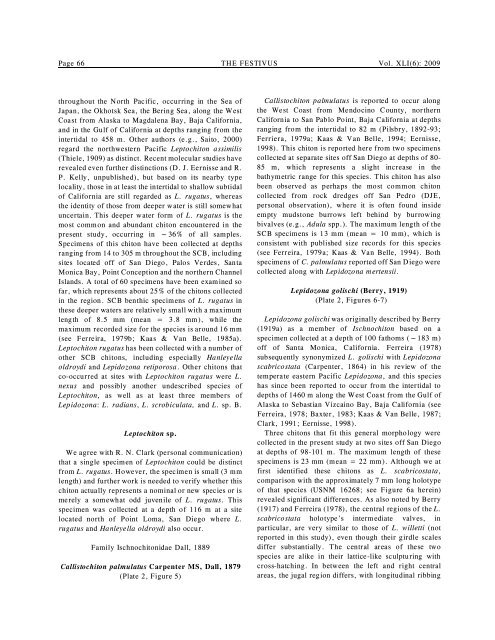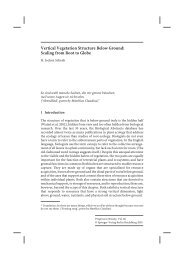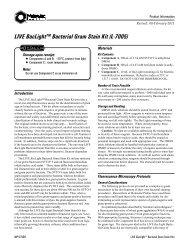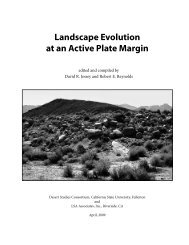Chitons (Mollusca: Polyplacophora) - Biological Science - California ...
Chitons (Mollusca: Polyplacophora) - Biological Science - California ...
Chitons (Mollusca: Polyplacophora) - Biological Science - California ...
You also want an ePaper? Increase the reach of your titles
YUMPU automatically turns print PDFs into web optimized ePapers that Google loves.
Page 66 THE FESTIVUS Vol. XLI(6): 2009<br />
throughout the North Pacific, occurring in the Sea of<br />
Japan, the Okhotsk Sea, the Bering Sea, along the West<br />
Coast from Alaska to Magdalena Bay, Baja <strong>California</strong>,<br />
and in the Gulf of <strong>California</strong> at depths ranging from the<br />
intertidal to 458 m. Other authors (e.g., Saito, 2000)<br />
regard the northwestern Pacific Leptochiton assimilis<br />
(Thiele, 1909) as distinct. Recent molecular studies have<br />
revealed even further distinctions (D. J. Eernisse and R.<br />
P. Kelly, unpublished), but based on its nearby type<br />
locality, those in at least the intertidal to shallow subtidal<br />
of <strong>California</strong> are still regarded as L. rugatus, whereas<br />
the identity of those from deeper water is still somewhat<br />
uncertain. This deeper water form of L. rugatus is the<br />
most common and abundant chiton encountered in the<br />
present study, occurring in ~36% of all samples.<br />
Specimens of this chiton have been collected at depths<br />
ranging from 14 to 305 m throughout the SCB, including<br />
sites located off of San Diego, Palos Verdes, Santa<br />
Monica Bay, Point Conception and the northern Channel<br />
Islands. A total of 60 specimens have been examined so<br />
far, which represents about 25% of the chitons collected<br />
in the region. SCB benthic specimens of L. rugatus in<br />
these deeper waters are relatively small with a maximum<br />
length of 8.5 mm (mean = 3.8 mm), while the<br />
maximum recorded size for the species is around 16 mm<br />
(see Ferreira, 1979b; Kaas & Van Belle, 1985a).<br />
Leptochiton rugatus has been collected with a number of<br />
other SCB chitons, including especially Hanleyella<br />
oldroydi and Lepidozona retiporosa. Other chitons that<br />
co-occurred at sites with Leptochiton rugatus were L.<br />
nexus and possibly another undescribed species of<br />
Leptochiton, as well as at least three members of<br />
Lepidozona: L. radians, L. scrobiculata, and L. sp. B.<br />
Leptochiton sp.<br />
We agree with R. N. Clark (personal communication)<br />
that a single specimen of Leptochiton could be distinct<br />
from L. rugatus. However, the specimen is small (3 mm<br />
length) and further work is needed to verify whether this<br />
chiton actually represents a nominal or new species or is<br />
merely a somewhat odd juvenile of L. rugatus. This<br />
specimen was collected at a depth of 116 m at a site<br />
located north of Point Loma, San Diego where L.<br />
rugatus and Hanleyella oldroydi also occur.<br />
Family Ischnochitonidae Dall, 1889<br />
Callistochiton palmulatus Carpenter MS, Dall, 1879<br />
(Plate 2, Figure 5)<br />
Callistochiton palmulatus is reported to occur along<br />
the West Coast from Mendocino County, northern<br />
<strong>California</strong> to San Pablo Point, Baja <strong>California</strong> at depths<br />
ranging from the intertidal to 82 m (Pilsbry, 1892-93;<br />
Ferriera, 1979a; Kaas & Van Belle, 1994; Eernisse,<br />
1998). This chiton is reported here from two specimens<br />
collected at separate sites off San Diego at depths of 80-<br />
85 m, which represents a slight increase in the<br />
bathymetric range for this species. This chiton has also<br />
been observed as perhaps the most common chiton<br />
collected from rock dredges off San Pedro (DJE,<br />
personal observation), where it is often found inside<br />
empty mudstone burrows left behind by burrowing<br />
bivalves (e.g., Adula spp.). The maximum length of the<br />
SCB specimens is 13 mm (mean = 10 mm), which is<br />
consistent with published size records for this species<br />
(see Ferreira, 1979a; Kaas & Van Belle, 1994). Both<br />
specimens of C. palmulatus reported off San Diego were<br />
collected along with Lepidozona mertensii.<br />
Lepidozona golischi (Berry, 1919)<br />
(Plate 2, Figures 6-7)<br />
Lepidozona golischi was originally described by Berry<br />
(1919a) as a member of Ischnochiton based on a<br />
specimen collected at a depth of 100 fathoms (~183 m)<br />
off of Santa Monica, <strong>California</strong>. Ferreira (1978)<br />
subsequently synonymized L. golischi with Lepidozona<br />
scabricostata (Carpenter, 1864) in his review of the<br />
temperate eastern Pacific Lepidozona, and this species<br />
has since been reported to occur from the intertidal to<br />
depths of 1460 m along the West Coast from the Gulf of<br />
Alaska to Sebastian Vizcaino Bay, Baja <strong>California</strong> (see<br />
Ferreira, 1978; Baxter, 1983; Kaas & Van Belle, 1987;<br />
Clark, 1991; Eernisse, 1998).<br />
Three chitons that fit this general morphology were<br />
collected in the present study at two sites off San Diego<br />
at depths of 98-101 m. The maximum length of these<br />
specimens is 23 mm (mean = 22 mm). Although we at<br />
first identified these chitons as L. scabricostata,<br />
comparison with the approximately 7 mm long holotype<br />
of that species (USNM 16268; see Figure 6a herein)<br />
revealed significant differences. As also noted by Berry<br />
(1917) and Ferreira (1978), the central regions of the L.<br />
scabricostata holotype’s intermediate valves, in<br />
particular, are very similar to those of L. willetti (not<br />
reported in this study), even though their girdle scales<br />
differ substantially. The central areas of these two<br />
species are alike in their lattice-like sculpturing with<br />
cross-hatching. In between the left and right central<br />
areas, the jugal region differs, with longitudinal ribbing
















